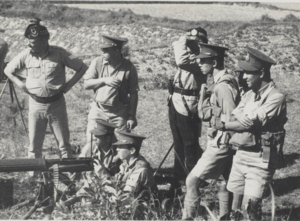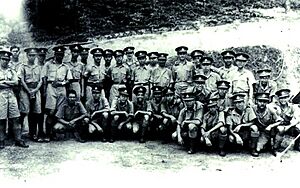Royal Hong Kong Regiment facts for kids
Quick facts for kids Royal Hong Kong Regiment (The Volunteers) |
||||
|---|---|---|---|---|

Coat of arms of the Royal Hong Kong Regiment (The Volunteers)
|
||||
| Active | 1854–1995 | |||
| Country | ||||
| Branch | ||||
| Type | local auxiliary militia | |||
| Garrison/HQ | Hong Kong Garrison | |||
| Motto(s) | Nulli Secundus in Oriente (Second to None in the East) | |||
| Colours | red, yellow, blue |
|||
| Anniversaries | 1854, 1971, 1995 | |||
| Engagements | Battle of Hong Kong | |||
| Royal Hong Kong Regiment | |||||||||
|---|---|---|---|---|---|---|---|---|---|
| Traditional Chinese | 皇家香港軍團(義勇軍) | ||||||||
|
|||||||||
The Royal Hong Kong Regiment (The Volunteers) (RHKR(V)) was a special local army group in Hong Kong. It was formed in May 1854. This group was like a part-time army, called a militia, that helped defend Hong Kong. The government of Hong Kong paid for and managed this group. Their duties were set out by a special law.
During the time when Britain had many colonies, local defence groups were created. This helped the main British Army units move to other places. These local groups were set up much like the British Army. The Hong Kong Volunteers was the first local militia in Hong Kong. It was the start of what became the Royal Hong Kong Regiment (The Volunteers).
Even though the British government was in charge of defending its colonies, local forces like the RHKR(V) were funded by the local government. This meant the RHKR(V) was always part of the Hong Kong government. It was not a regular part of the British Army. However, the RHKR(V) did work with the British forces in Hong Kong.
These local defence groups were very well trained and organized. Many of their officers and leaders went to the UK for training. Members of these groups could not be forced to serve outside Hong Kong. But many chose to volunteer and help other British Army units in different places. The regiment was officially closed down in 1995. It is different from another group called the Hong Kong Regiment (1892–1902). That was a regular British Army group, not a local volunteer one.
Contents
History of the Regiment
How it Started

The Hong Kong Volunteers was created in 1854. This happened because the Crimean War meant fewer British soldiers were in Hong Kong. To help protect the area, especially from pirates, local people were asked to volunteer. About 99 Europeans joined, mostly British, but also some Portuguese, Scandinavians, and Germans. However, the group was soon disbanded when the war threat in Europe ended. British Army units then returned to protect Hong Kong.
In 1862, the Hong Kong Volunteers started up again. In 1864, they helped stop a serious riot between British and Indian soldiers. But in 1866, it was disbanded once more. In 1878, the Hong Kong Volunteers was reborn with a new name: the "Hong Kong Artillery and Rifle Volunteer Corps". By 1917, it was called the "Hong Kong Defence Corps". This group was very busy during World War I. They did guard and patrol duties because most British forces had been called away. They were the only military group left in Hong Kong at that time.
In 1933, the Hong Kong Defence Corps got its first armoured car. It had strong armour and mounts for two machine guns. Later, the government bought four more. A local company, the Hong Kong and Whampoa Dock Company, built their bodies. These armoured cars were very important in the Battle of Hong Kong in December 1941.
World War II and the Battle of Hong Kong

The Hong Kong Defence Corps was renamed the "Hong Kong Volunteer Defence Corps" (HKVDC). They faced their biggest challenge during the tough fighting in the weeks before Hong Kong fell. This happened on Christmas Day 1941. On December 8, 1941, the HKVDC had about 2200 soldiers ready to fight. They had infantry companies, artillery units, machine gun companies, and an armoured car team.
At the start of the Japanese attack, the Volunteers saw little action in the New Territories. But they fought very hard on Hong Kong Island. Key battles happened at Wong Nai Chung Gap and Stanley. Many soldiers from the 3rd Company and 1st Battery were lost in these battles. Other companies also suffered heavy losses.
Out of 2200 soldiers, 289 were either missing or killed. Many others became prisoners of war. However, some managed to escape into China. There, they joined the British Army Aid Group. This group helped the Chinese government fight against the Japanese. Some of these men later joined the Hong Kong Volunteer Company in Burma. They worked with a special force called the Chindits. The brave actions of the defence corps were later recognized with many awards. They also received the battle honour "Hong Kong."
The special flags of the Hong Kong Volunteer Defence Corps were hidden during the battle. Lieutenant Ralph James Shrigley buried them near the regiment's headquarters. This was to stop the Japanese from capturing them. The burial spot was found in 1957, but the flags had fallen apart. Only the poles remained.
After World War II

In 1949, the Hong Kong Regiment was reorganized. It became part of the Hong Kong Defence Force. This force also included separate air and naval units. In 1951, the new combined defence force was given the title 'Royal'. New special flags were given to the regiment.
In the early 1960s, the role of the Royal Hong Kong Defence Force changed. It went from being an infantry battalion to a reconnaissance regiment. This meant they focused on scouting and gathering information. They got six British Ferret armoured cars. Each car had a machine gun. The regiment was reorganized into different squadrons and companies. During the 1967 riots, the Royal Hong Kong Defence Force was called out to help. The RHKR also helped start the Junior Leaders Corps in 1969.
By 1970, the naval unit was removed. In 1970, the Royal Hong Kong Defence Force itself was disbanded. The two remaining parts, the Hong Kong Regiment and the Hong Kong Auxiliary Air Force, became separate groups. At the same time, Queen Elizabeth II gave both groups the 'Royal' title. The words 'The Volunteers' were added to the Hong Kong Regiment's name. With its new name and flags, the RHKR(V) became a light reconnaissance unit. It worked under the British Forces in Hong Kong.
In the late 1970s, the Volunteers helped the government with illegal immigration from China. As this problem grew from 1980 to 1992, the Volunteers were sent to guard the border. In the late 1980s and early 1990s, the Volunteers helped control the large number of Vietnamese illegal migrants. These people were often called "Boat People". This work included guarding temporary camps for these migrants.
How the Regiment was Organized
The regiment had several different parts:
- Regimental Headquarters: This was the main office.
- Headquarters Squadron: A unit that supported the main office.
- A, B, C, D Saber Squadron: These were the main fighting units.
- Regimental Police: They kept order within the regiment.
- Home Guard Squadron: A unit for local defence.
- Training Squadron: This unit was in charge of training soldiers.
- Band: The regiment also had its own band.
- Junior Leader Corps: This was a youth group started by the RHKR(V) in 1971. It is now called the Hong Kong Adventure Corps.
The End of the Regiment
The Sino-British Joint Declaration was an agreement about Hong Kong's future as a British colony. It was signed in Beijing on December 19, 1984. This agreement officially started on May 27, 1985. It was registered with the United Nations in June 1985.
In April 1992, the Hong Kong Government announced that the regiment would close down. The RHKR was officially disbanded on September 3, 1995.
Commanding Officers
- Lt Col K B L Simson (April 1993 - September 3, 1995)
After the regiment closed, the Royal Hong Kong Regiment (The Volunteers) Association was created in 1995. This group helps former members in Hong Kong. They have a Club House at the Hong Kong Jockey Club Happy Valley Racecourse.
Changes in Name Over Time
The regiment had several different names throughout its history:
- 1854 – Hong Kong Volunteers
- 1878 – Hong Kong Artillery and Rifle Volunteer Corps
- 1917 – Hong Kong Defence Corps
- 1920 – Hong Kong Volunteer Defence Corps
- 1949 – Hong Kong Defence Force
- 1951 – Royal Hong Kong Defence Force
- 1961 – Hong Kong Regiment (The Volunteers)
- 1970 – Royal Hong Kong Regiment (The Volunteers)
Equipment Used by the Regiment
Vehicles
Here are some vehicles the regiment used before it closed:
1925-1965
- One armoured car on a Ford chassis with a Vickers machine gun (1920s).
- One armoured car on a Dennis chassis (1925), changed by Hong Kong & Whampoa Dock.
- Two armoured cars on Thornycroft chassis (1930-1933), built by Hong Kong & Whampoa Dock.
- Motorcycles with Vickers machine guns.
- Four armoured cars on Bedford chassis (1940-1941), built by Kowloon-Canton Railway Corporation.
1965-1995
- Six Ferret scout cars (1963).
- Two Landrovers.
- Land Rover Defenders (from British Army units in Hong Kong during the 1970s to 1990s).
Weapons
Here are some of the small weapons the RHKR used before it closed:
- Lee–Enfield No.4 MkI rifle
- L1A1 Self-Loading Rifle
- Colt M16A2 rifle
- Colt "Commando" M177 Assault Carbine
- SA80 L85
- Sterling submachine gun (SMG) 9mm L2A
- FN MAG General-purpose machine gun (GPMG)
- Bren LMG
- M1919 Browning machine gun
- Remington Model 870 Shotgun
- Browning Hi-Power
Regiment Badge
The regiment's badge when it closed had these parts:
- A St. Edward's Crown (a type of crown).
- Two Chinese dragons holding up the crown.
- Its motto: Nulli Secundus in Oriente, which means "Second to None in the East."
Older badges had a different type of crown, called a Tudor Crown. The very early Volunteer Corps badges did not have any Chinese features. They had:
- A Tudor Crown.
- A ribbon with the regiment's name.
- The Coat of Arms of the United Kingdom inside the ribbon.
- The motto: Nulli Secundus in Oriente.
- A Laurel wreath (a circle of leaves).
Colours and Guidons
See also





